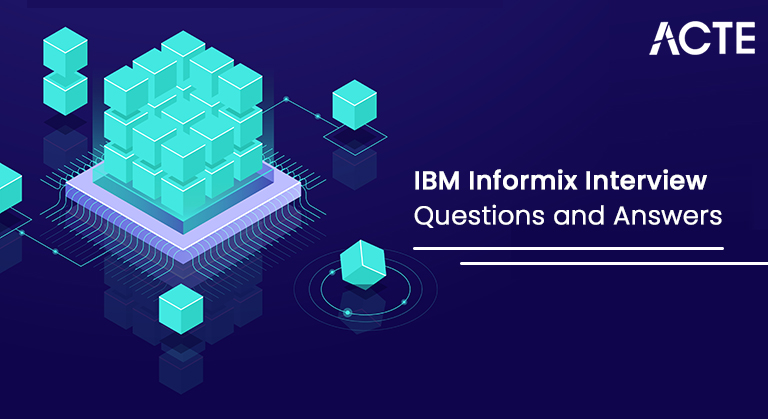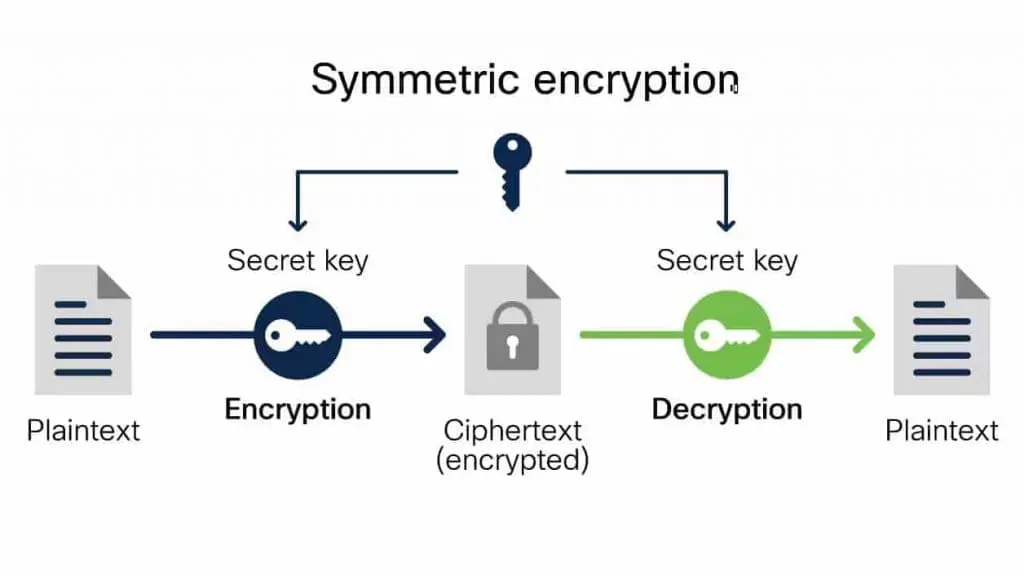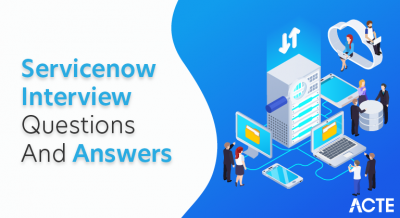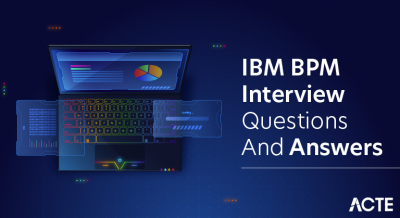
Looking for the top IBM Informix interview questions to prepare for your interview. Go through some of the best IBM Informix interview questions with detailed answers before you get ahead. IBM Informix to become an Expert in IBM Informix and learn all the instructions required to install and configure the server. Therefore, IBM Informix professionals need to encounter interview questions on IBM Informix for different enterprise IBM Informix job roles. The following discussion offers an overview of different categories of interview questions related to IBM Informix to help aspiring enterprise IBM Informix Professionals.
1. What is IBM Informix and its primary features?
Ans:
IBM Informix is a robust relational database management system.
It offers high performance, scalability, and low administration overhead.
Features include ACID transactions, flexible data storage, replication, high availability, and advanced security.
2. Describe the key components of Informix architecture.
Ans:
- Informix architecture includes the Database Server, Storage Manager, SQL Engine, and Transaction Manager.
- The Database Server manages data storage, processing, and access.
- Storage Manager handles physical storage, SQL Engine processes queries, and Transaction Manager ensures data integrity.
3. How does Informix ensure data integrity and consistency?
Ans:
- Informix ensures data integrity through its Transaction Manager.
- ACID transactions guarantee Atomicity, Consistency, Isolation, and Durability.
- Isolation levels prevent data inconsistencies by managing concurrent transactions.
4. Explain the difference between an Informix instance and a database.
Ans:
| Feature | Informix Instance | Database | |
| Definition |
Entire Informix server process running on a system |
Logical container for storing data. | |
| Management | Manages system resources such as CPU, memory, disk I/O | Contains tables, indexes, procedures, etc. | |
| Scope | Hosts one or more databases | Contains data and database objects. |
5. What are the storage mechanisms supported by Informix?
Ans:
Informix supports raw devices, cooked files, and Informix Flexible Grid. Raw devices provide direct disk access for performance, cooked files offer flexibility managed by the OS, and Flexible Grid allows dynamic storage allocation across nodes for scalability.
6. How does Informix handle concurrency control and transaction management?
Ans:
Informix ensures data integrity with MVCC and isolation levels. MVCC maintains different data versions for concurrent access, while adherence to ACID properties guarantees transactional integrity, ensuring reliable data operations.
7. Discuss the types of locks used in Informix.
Ans:
Informix employs Shared (S) locks for reading, Update (U) locks for writing, and Intent (I) locks to signal higher-level lock intentions. These locks prevent data anomalies in multi-user environments, ensuring data consistency and integrity.
8. Explain the purpose of Informix’s Physical and Logical Logging.
Ans:
Informix uses Physical and Logical Logging for data durability and recovery. Physical Logging records physical changes like page modifications, while Logical Logging captures high-level database operations. Together, they facilitate efficient recovery and rollback procedures, ensuring data integrity and system reliability.
9. What is the significance of the Informix Onstat utility?
Ans:
Onstat utility provides real-time monitoring and diagnostic information about the Informix instance. It helps administrators analyze performance, identify bottlenecks, and troubleshoot issues promptly, ensuring optimal database operation.
10. How does Informix handle SQL queries and optimization?
Ans:
Informix processes SQL queries efficiently using its SQL Engine. It optimizes queries by analyzing query plans, selecting the best execution strategy, and utilizing indexing, statistics, and join techniques to improve performance and resource utilization.
11. Discuss the indexing strategies available in Informix.
Ans:
Informix offers various indexing strategies including B-tree, Bitmap, and Functional indexes. B-tree indexes are suitable for range queries, Bitmap indexes for low-cardinality columns, and Functional indexes for computed expressions. Choosing the appropriate index type depends on query patterns and data characteristics.
12. Explain the role of Informix’s query optimizer.
Ans:
Informix’s query optimizer analyzes SQL queries, generates candidate execution plans, and selects the most efficient plan based on cost estimation. It considers factors like index usage, join methods, and access paths to optimize query performance, ensuring optimal resource utilization and response time.
13. What are the different types of joins supported in Informix?
Ans:
Informix supports various types of joins including inner join, outer join (left, right, and full), and cross join. These joins allow for combining data from multiple tables based on specified conditions.
14. How does Informix support distributed database management?
Ans:
Informix facilitates distributed database management through its Distributed Relational Database Architecture (DRDA), allowing users to access and manage data across multiple Informix instances and heterogeneous data sources seamlessly.
15. Discuss Informix’s support for high availability and disaster recovery.
Ans:
Informix offers robust features for high availability and disaster recovery including Enterprise Replication, HDR (High Availability Data Replication), SDS (Shared Disk Secondary), and Log-based Replication. These features ensure continuous availability of data, minimize downtime, and enable quick recovery in case of disasters.
16. Explain the concepts of Informix replication and synchronization.
Ans:
Informix replication involves copying and distributing data from one database to another to ensure data consistency and availability. It includes techniques like log-based replication and trigger-based replication. Synchronization ensures that replicated databases remain consistent with the source database, updating changes in real-time or through scheduled intervals.
17. What are the different replication modes in Informix?
Ans:
Informix supports various replication modes including unidirectional, bidirectional, and multidirectional replication. These modes allow data to be replicated between multiple databases in different configurations to suit specific business requirements.
18. How does Informix handle backup and recovery operations?
Ans:
Informix provides tools and utilities such as ontape and onbar for performing backup and recovery operations. These tools enable users to create full, incremental, or differential backups and restore data in case of system failures, ensuring data integrity and business continuity.
19. Describe the role of Informix’s Enterprise Replication feature.
Ans:
Enterprise Replication in Informix enables the replication of data between different Informix databases in real-time. It ensures data consistency and availability across distributed environments, supporting various replication topologies and configurations to meet business needs.
20. Discuss Informix’s support for stored procedures and triggers.
Ans:
Informix allows the creation of stored procedures and triggers using SPL (Stored Procedure Language). Stored procedures are precompiled SQL statements stored in the database and executed when called, while triggers are special types of stored procedures invoked automatically in response to predefined database events. They enhance data integrity, enforce business rules, and streamline database operations.
21. Explain Informix’s support for user-defined data types.
Ans:
Informix allows users to define custom data types using the CREATE DATATYPE statement. This feature enables the creation of domain-specific data types tailored to specific application requirements, enhancing data integrity and simplifying data management.
22. How does Informix handle large objects (LOBs)?
Ans:
Informix supports large objects (LOBs) such as BLOBs (Binary Large Objects) and CLOBs (Character Large Objects) for storing large data like images, documents, and multimedia files. It efficiently manages LOBs using storage optimization techniques, providing fast access and retrieval capabilities.
23. Discuss Informix’s support for spatial data and geospatial indexing.
Ans:
Informix offers robust support for spatial data types and geospatial indexing through its Spatial Extender feature. This feature enables the storage and manipulation of spatial data such as points, lines, and polygons, along with advanced spatial analysis and querying capabilities. Geospatial indexing enhances performance for spatial queries, allowing efficient retrieval of spatial data based on proximity and spatial relationships.
24. What are the security features available in Informix?
Ans:
Role-Based Access Control (RBAC) : Users are assigned roles with specific privileges.
Encryption : Supports encryption for data-at-rest and data-in-motion, enhancing data security.
Auditing : Tracks and logs user activities for accountability and compliance purposes.
Fine-Grained Access Controls : Allows granular control over data access, restricting sensitive data access.
Integration : Integrates with external authentication mechanisms like LDAP and Kerberos for enhanced authentication.
25. Explain the process of installing and configuring an Informix instance.
Ans:
The process involves downloading the Informix installer, running it, and following the installation wizard prompts. Configuration includes setting environment variables, configuring storage, defining instance parameters, and creating databases using tools like “oninit” and “onspaces.”
26. How do you monitor and troubleshoot performance issues in Informix?
Ans:
Informix provides tools like “onstat” for real-time monitoring of server statistics and performance indicators. Analyzing query plans, identifying long-running queries, and optimizing indexes can help address performance bottlenecks. Additionally, performance monitoring tools and third-party solutions can aid in identifying and resolving issues.
27. Discuss Informix’s support for time series data and temporal tables.
Ans:
Informix offers native support for time series data through its TimeSeries DataBlade module, enabling efficient storage and querying of time-stamped data. Temporal tables allow historical data tracking with built-in time-based versioning, facilitating easy retrieval of past data states.
28. Explain the concepts of Informix fragmentation and table partitioning.
Ans:
Fragmentation involves dividing tables into smaller fragments for improved performance and manageability. Table partitioning allows splitting large tables into smaller partitions based on specific criteria like range or hash, enhancing data organization, query performance, and maintenance efficiency.
29. How does Informix handle multitenancy and isolation levels?
Ans:
Informix supports multitenancy through database and table-level isolation, allowing multiple tenants to share the same instance while maintaining data separation and security. It provides isolation levels like Read Uncommitted, Read Committed, Repeatable Read, and Serializable to control transaction consistency and concurrency.
30. Discuss Informix’s support for Java and .NET application development.
Ans:
Informix offers JDBC and ODBC drivers for Java and .NET application development, enabling seamless integration with applications written in these languages. Additionally, Informix provides client libraries, APIs, and development tools to facilitate application development and connectivity.
31. Explain the role of Informix’s Backup and Restore Manager (BRM).
Ans:
BRM is a utility in Informix used for managing backup and restore operations. It provides a centralized interface for scheduling, monitoring, and managing backup and restore tasks across Informix instances. BRM streamlines backup and recovery processes, ensuring data protection and availability.
32. What are the different types of backups supported in Informix?
Ans:
Informix supports various types of backups including full, incremental, and continuous (incremental level 0 and level 1). Continuous backups offer real-time data protection by continuously capturing changes as they occur, minimizing data loss in case of failures.
33. Discuss Informix’s support for JSON and NoSQL data.
Ans:
Informix supports JSON data type for storing and querying semi-structured data, offering flexibility and schema-less storage. Additionally, Informix provides NoSQL capabilities through its support for MongoDB wire protocol, enabling seamless integration with NoSQL databases and applications.
34. Explain the concepts of Informix’s Flexible Grid and Multi-node Cluster.
Ans:
Informix’s Flexible Grid allows dynamic addition or removal of nodes to/from a cluster without downtime, enabling scalability and high availability. Multi-node Cluster enhances fault tolerance by distributing data across multiple nodes, ensuring reliability and performance even in case of node failures.
35. How does Informix handle automatic storage management?
Ans:
Informix features Automatic Storage Provisioning (ASP) for simplified storage management. ASP automatically manages storage allocation, distribution, and resizing, optimizing storage utilization and simplifying administrative tasks, reducing operational overhead and improving resource efficiency.
36. Discuss the features and benefits of Informix’s Workload Management.
Ans:
Informix’s Workload Management enables administrators to prioritize and manage resource allocation based on workload requirements. It ensures optimal performance and resource utilization by allocating resources dynamically, managing concurrency, and enforcing resource limits, enhancing system stability, and responsiveness.
37. Explain the concepts of Informix’s Fragment-Level Statistics.
Ans:
Fragment-Level Statistics in Informix provide detailed performance metrics for individual data fragments within fragmented tables. These statistics help in optimizing query performance by allowing administrators to analyze and understand data distribution and access patterns at a granular level.
38. What are the different types of logging supported in Informix?
Ans:
Informix supports Physical Logging and Logical Logging. Physical Logging records physical changes to database pages, while Logical Logging captures high-level database operations such as inserts, updates, and deletes. These logging mechanisms ensure data durability and facilitate recovery in case of system failures.
39. Discuss Informix’s support for in-memory databases.
Ans:
Informix offers support for in-memory databases, allowing users to store and manipulate data entirely in memory for faster access and processing. This feature enhances performance for real-time analytics, high-speed transactions, and other latency-sensitive applications.
40. How does Informix support compatibility with other databases?
Ans:
Informix provides compatibility features such as ODBC and JDBC drivers, allowing applications written for other databases to connect and interact with Informix databases seamlessly. Additionally, Informix supports SQL standards and offers tools for data migration and replication, facilitating interoperability with various database platforms.
41. Explain the purpose of Informix’s High-Performance Loader (HPL).
Ans:
Informix’s High-Performance Loader (HPL) is a utility used for fast and efficient loading of large volumes of data into Informix databases. It achieves high throughput by optimizing data loading operations, utilizing parallel processing, and minimizing disk I/O, enabling rapid data ingestion for batch processing scenarios.
42. What are the different types of triggers supported in Informix?
Ans:
Informix supports Row-Level and Statement-Level triggers. Row-Level triggers execute once for each row affected by the triggering event, while Statement-Level triggers execute once per triggering SQL statement. These triggers enable developers to enforce business rules, maintain data integrity, and automate tasks based on database events.
43. Discuss Informix’s support for parallel query execution.
Ans:
Informix supports parallel query execution, allowing queries to be processed concurrently across multiple CPU cores or nodes in a cluster. This feature enhances query performance by leveraging parallelism to divide and conquer large datasets, reducing query execution time and improving overall system throughput.
44. Explain the role of Informix’s Connection Manager.
Ans:
Informix’s Connection Manager serves as middleware, managing client connections to Informix databases. It facilitates efficient routing of client requests to database servers, optimizing connection management. By handling load balancing and connection pooling, it enhances scalability and improves overall system performance. The Connection Manager plays a crucial role in ensuring reliable and responsive access to Informix databases for client applications.
45. How does Informix handle data encryption and masking?
Ans:
Informix supports data encryption through various encryption algorithms and provides features for encrypting data-at-rest and data-in-motion. Additionally, Informix offers data masking capabilities to obfuscate sensitive data, ensuring confidentiality and compliance with data protection regulations.

46. Discuss Informix’s support for compression and deduplication.
Ans:
Informix offers compression features to reduce storage footprint and optimize disk space utilization. It supports both row-level and page-level compression techniques, minimizing storage requirements and improving performance. Additionally, Informix provides deduplication capabilities to eliminate redundant data, further reducing storage overhead and enhancing data efficiency.
47. What are the different types of data replication methods in Informix?
Ans:
Informix supports various data replication methods including log-based replication, trigger-based replication, and enterprise replication. Log-based replication captures changes from the transaction log and replicates them to target databases, while trigger-based replication uses triggers to propagate changes. Enterprise replication offers bidirectional replication and conflict resolution capabilities, enabling data synchronization across distributed environments.
48. Explain the role of Informix’s DataBlade modules.
Ans:
Informix’s DataBlade modules augment the database’s functionality by providing specialized features tailored to distinct use cases. These modules extend Informix’s capabilities beyond its core functionalities, enabling advanced data management tasks such as spatial data handling, time series analysis, text search, and multimedia data processing. With DataBlade modules, Informix offers a flexible and customizable platform adaptable to diverse business needs and industry requirements.
49. Discuss Informix’s support for workload balancing and failover.
Ans:
Informix employs features like Connection Manager and Enterprise Replication to balance workloads across multiple database servers. It ensures high availability and fault tolerance through techniques like automatic failover and data replication, minimizing downtime and ensuring continuous access to data.
50. Explain the role of Informix’s SQL administration API.
Ans:
Informix’s SQL administration API provides programmatic access to administrative tasks such as database creation, user management, and configuration settings. It allows automation of routine administrative tasks and integration with management tools, simplifying database administration and enhancing operational efficiency.
51. How does Informix handle distributed transactions?
Ans:
Informix supports distributed transactions through its Distributed Relational Database Architecture (DRDA). It enables coordination and synchronization of transactions across multiple Informix instances or heterogeneous databases, ensuring data consistency and integrity in distributed environments.
52. Explain the role of Informix’s Scheduler and Task Manager.
Ans:
The Scheduler allows users to automate the execution of tasks, such as backups or data imports, at specified times or intervals. Task Manager oversees these scheduled tasks, ensuring they execute as planned, monitoring their progress, and handling any errors or exceptions that may occur during execution.
53. What are the different types of replication filters supported in Informix?
Ans:
Informix supports replication filters such as table-level, column-level, and row-level filters. These filters enable selective replication of data, allowing users to specify which tables, columns, or rows are replicated to target databases, optimizing replication performance and bandwidth usage.
54. Discuss Informix’s support for cloud integration and hybrid deployment.
Ans:
Informix offers features for seamless integration with cloud platforms, allowing users to deploy and manage Informix databases in the cloud. It supports hybrid deployment models, enabling organizations to integrate on-premises and cloud-based databases, ensuring data consistency and accessibility across environments.
55. What are the primary features of Informix?
Ans:
Informix offers a range of features including high availability, scalability, performance optimization, advanced security measures, flexible storage options, and compatibility with various programming languages and platforms. Its features cater to diverse business needs, ensuring reliable and efficient data management.
56. Explain the concept of Informix’s Smart BLOBs.
Ans:
Smart BLOBs in Informix are Binary Large Objects (BLOBs) that are stored in an optimized manner to enhance performance. They are managed differently from regular BLOBs, allowing for efficient storage, retrieval, and manipulation of large data objects such as images, documents, and multimedia files.
57. Discuss Informix’s support for multi-threaded query execution.
Ans:
Informix utilizes multi-threaded query execution to improve query performance and resource utilization. It allows multiple queries to be processed concurrently using separate threads, leveraging the available CPU cores efficiently and reducing query response time, especially in multi-user environments with high query loads.
58. What is the purpose of Informix’s Query Rewrite feature?
Ans:
Informix’s Query Rewrite feature optimizes SQL queries by automatically rewriting them to improve performance. It analyzes query patterns, access paths, and available indexes to generate more efficient query execution plans, reducing query execution time and enhancing overall system performance.
61. Explain the role of Informix’s Remote Data Access feature.
Ans:
Informix’s Remote Data Access feature enables users to access and manipulate data stored in remote Informix databases seamlessly. It facilitates data integration and collaboration across distributed environments, allowing applications to perform queries, updates, and transactions on remote data sources as if they were local.
62. How does Informix ensure data durability in case of system failures?
Ans:
Informix ensures data durability through mechanisms such as transaction logging and checkpoints. Transaction logs record changes to the database, allowing for recovery in the event of a system failure. Checkpoints periodically synchronize the transaction logs with the data files, ensuring that committed transactions are persisted to disk, even in the event of a crash.
63. What are the benefits of Informix’s Flexible Grid architecture?
Ans:
Informix ensures data durability through mechanisms such as transaction logging and checkpoints. Transaction logs record changes to the database, allowing for recovery in the event of a system failure. Checkpoints periodically synchronize the transaction logs with the data files, ensuring that committed transactions are persisted to disk, even in the event of a crash.
64. Discuss Informix’s support for data encryption at rest.
Ans:
Informix offers comprehensive data encryption capabilities to secure data stored in the database at rest. It supports industry-standard encryption algorithms such as AES (Advanced Encryption Standard) for encrypting data files and log files. This ensures that sensitive information remains confidential and protected from unauthorized access or theft. With Informix’s data encryption features, organizations can strengthen data security, meet regulatory compliance requirements, and mitigate the risk of data breaches effectively.
65. What is the significance of Informix’s Connection Pooling feature?
Ans:
Informix’s Connection Pooling feature enhances database performance and scalability by reusing established database connections rather than creating new ones for each client request. This reduces the overhead of connection establishment, improves response time, and optimizes resource utilization, especially in high-traffic environments with multiple concurrent users.
66. How does Informix handle distributed deadlock detection?
Ans:
Informix employs distributed deadlock detection mechanisms to identify and resolve deadlocks that may occur in distributed database transactions. It utilizes transaction timestamps, lock timeouts, and distributed lock manager coordination to detect deadlocks across multiple nodes. Upon detection, Informix resolves deadlocks by aborting one of the conflicting transactions, ensuring transactional consistency and preventing system deadlock
67. Explain the concept of Informix’s Change Data Capture (CDC).
Ans:
Informix’s Change Data Capture (CDC) feature captures and records changes made to database tables in real-time or near-real-time. It tracks data modifications, such as inserts, updates, and deletes, and stores them in a separate log or table. CDC enables applications to synchronize data between source and target systems, replicate changes to remote databases, and implement data integration and reporting solutions efficiently.
68. What are the advantages of using Informix’s Dynamic Server feature?
Ans:
Informix’s Dynamic Server feature offers enhanced scalability by dynamically allocating system resources to meet varying workload demands, ensuring efficient performance. It optimizes resource utilization by adjusting memory usage and thread concurrency dynamically, improving overall system efficiency. With Dynamic Server, Informix databases can seamlessly scale to accommodate growing data volumes and user loads, providing robust performance and reliability.
69. Discuss Informix’s support for spatial data analysis.
Ans:
Informix provides spatial data types and functions for storing and analyzing geometric and geographic data, enabling applications to perform operations such as proximity analysis, spatial joins, and spatial indexing for efficient spatial data management.
70. How does Informix handle temporary tables and table variables?
Ans:
Informix supports temporary tables and table variables for storing temporary data within a session or transaction. Temporary tables are created and dropped explicitly by users, while table variables are declared within a session and automatically dropped when the session ends, facilitating efficient data manipulation and processing.
71. Explain the role of Informix’s Resource Reservation feature.
Ans:
Informix’s Resource Reservation feature allows users to reserve system resources such as CPU, memory, and disk space for specific tasks or transactions. It ensures that critical operations have guaranteed access to necessary resources, preventing resource contention and improving system performance and stability.
72. What are the different isolation levels supported by Informix?
Ans:
Informix supports multiple isolation levels, including Read Uncommitted, Read Committed, Repeatable Read, and Serializable. These isolation levels determine the visibility of data modifications performed by concurrent transactions, allowing users to control transaction concurrency, consistency, and isolation levels based on their application requirements.
73. Discuss Informix’s support for advanced query optimization techniques.
Ans:
Informix employs various query optimization techniques, including cost-based optimization, query rewriting, index selection, and join ordering algorithms, to generate efficient query execution plans. These techniques improve query performance by minimizing resource usage and maximizing query execution speed, enhancing overall database performance.
74. How does Informix handle unstructured data storage?
Ans:
Informix supports unstructured data storage through Large Object (LOB) data types, such as BLOBs (Binary Large Objects) and CLOBs (Character Large Objects). These data types allow storage of large volumes of unstructured data, such as documents, images, and multimedia files, within the database, enabling efficient retrieval and manipulation of diverse data formats.
75. What is the purpose of Informix’s High Availability Data Replication (HDR)?
Ans:
Informix’s High Availability Data Replication (HDR) feature provides real-time data replication and failover capabilities to ensure high availability and data protection. HDR replicates data from a primary database server to one or more standby servers, allowing automatic failover in case of primary server failure, minimizing downtime and data loss, and ensuring continuous access to critical data.
76. Explain the concept of Informix’s Flexible Replication.
Ans:
Informix’s Flexible Replication feature allows users to replicate data between Informix databases flexibly. It supports various replication topologies, including master-slave, peer-to-peer, and cascading replication, enabling users to tailor replication configurations to their specific requirements. Flexible Replication ensures data consistency, scalability, and fault tolerance across distributed database environments, enhancing system reliability and performance.
77. How does Informix support workload prioritization?
Ans:
Informix allows users to prioritize workloads by assigning different levels of importance to queries and transactions. It provides features like Resource Reservation and Query Throttling to allocate resources and control the execution of queries based on their priority, ensuring that critical operations receive precedence over less important ones.
78. Discuss Informix’s support for XML data processing.
Ans:
Informix offers XML data type support and XML-related functions for storing, querying, and manipulating XML data within the database. It provides XML indexing and parsing capabilities, allowing efficient storage and retrieval of XML documents, and supports XPath and XQuery for querying XML data, enabling seamless integration of XML data into database applications.
79. What is the role of Informix’s Shared Disk Secondary (SDS) feature?
Ans:
Informix’s Shared Disk Secondary (SDS) feature provides high availability and fault tolerance by maintaining a synchronized standby database on shared storage. In the event of a primary server failure, SDS enables automatic failover to the standby server, ensuring uninterrupted access to data and minimizing downtime.
80. Explain the significance of Informix’s Data Encryption at Rest (DEAR).
Ans:
Informix’s Data Encryption at Rest (DEAR) feature encrypts data stored in the database files and log files, ensuring confidentiality and protection against unauthorized access. It enhances data security, compliance with regulatory requirements, and mitigates the risk of data breaches by safeguarding sensitive information even if physical storage media are compromised.
81. How does Informix support data partitioning?
Ans:
Informix supports data partitioning by allowing users to divide large tables into smaller partitions based on specific criteria such as range, hash, or list partitioning. This enables data distribution across multiple storage devices, improving query performance, scalability, and manageability.
82. Discuss Informix’s support for full-text search capabilities.
Ans:
Informix provides built-in full-text search capabilities through Text Search indexes, allowing users to efficiently search and retrieve text data stored in the database. It supports advanced search features such as stemming, fuzzy matching, and proximity searches, enhancing search accuracy and relevance.
83. What are the benefits of using Informix’s Dynamic SQL feature?
Ans:
Informix’s Dynamic SQL feature allows users to construct and execute SQL statements dynamically at runtime. This offers flexibility in query generation and execution, enabling applications to adapt to changing requirements and user inputs dynamically, improving code reusability and flexibility.
84. Explain the concept of Informix’s Automatic Storage Provisioning (ASP).
Ans:
Informix’s Automatic Storage Provisioning (ASP) feature automatically manages storage allocation and provisioning for database objects such as tables, indexes, and temporary spaces. It dynamically adjusts storage allocation based on data growth and usage patterns, optimizing storage utilization and simplifying database administration tasks.
85. What is the purpose of Informix’s Data Masking feature?
Ans:
Informix’s Data Masking feature is designed to protect sensitive data by obfuscating or anonymizing it. It helps organizations comply with data privacy regulations by preventing unauthorized access to confidential information while allowing authorized users to perform necessary tasks.
86. How does Informix handle query optimization for complex queries?
Ans:
Informix utilizes a variety of query optimization techniques, including cost-based optimization, query rewriting, and index selection algorithms, to optimize the execution of complex queries. It analyzes query plans, statistics, and available indexes to generate efficient execution plans, ensuring optimal performance even for complex queries with multiple joins and subqueries.
87. Discuss Informix’s support for advanced analytics and machine learning.
Ans:
Informix offers advanced analytics and machine learning capabilities through its Informix Warehouse Accelerator (IWA) and built-in support for R programming language. It enables users to perform complex analytical tasks such as predictive modeling, pattern recognition, and data mining directly within the database, leveraging in-memory processing and parallel execution for high-performance analytics.
88. What is the significance of Informix’s TimeSeries DataBlade module?
Ans:
Informix’s TimeSeries DataBlade module provides specialized support for storing and analyzing time-series data, such as sensor data, financial market data, and IoT data. It offers optimized storage structures, indexing techniques, and query processing algorithms tailored for time-series data, enabling efficient storage, retrieval, and analysis of time-stamped data points.
89. Explain the role of Informix’s Logical Log Replication feature.
Ans:
Informix’s Logical Log Replication feature facilitates the replication of transactional changes from a primary database server to one or more secondary servers in near real-time. It captures data modifications recorded in the logical logs and applies them to the secondary servers, ensuring data consistency across distributed environments and providing high availability and disaster recovery capabilities.
90. How does Informix ensure data consistency in a clustered environment?
Ans:
Informix ensures data consistency in a clustered environment through mechanisms such as Two-Phase Commit (2PC) and Distributed Relational Database Architecture (DRDA). These mechanisms coordinate transactional operations across multiple nodes in the cluster, ensuring that changes are applied atomically and consistently across the distributed database system. Additionally, Informix’s Multi-Version Concurrency Control (MVCC) ensures that transactions access a consistent snapshot of the database, preventing data anomalies and ensuring transaction isolation and integrity.






